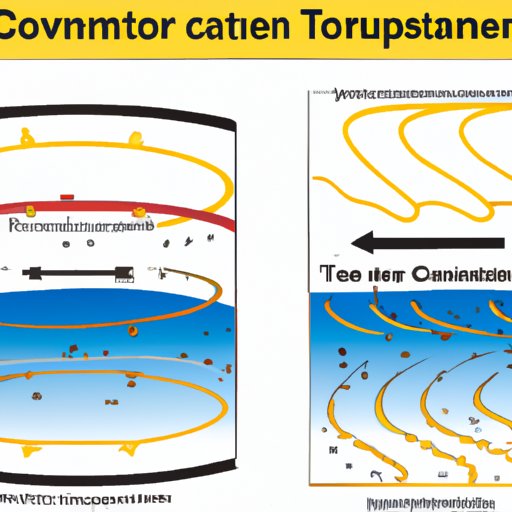Introduction
Have you ever wondered how heat is transferred from one place to another? This process is known as convection, and it occurs in a variety of different environments. In this article, we will take an in-depth look at convection, exploring the science behind it and examining its physical properties. By the end, you’ll have a comprehensive understanding of this fascinating phenomenon.

An Introduction to Convection and Its Mechanisms
So what exactly is convection? According to the National Weather Service, “Convection is the transfer of heat by the movement of a fluid such as air or water.” In other words, convection is the process by which heat is transferred from one place to another via the movement of particles. This can occur in both air and water, and it is responsible for many of the weather phenomena that we observe every day.
To better understand convection, let’s take a closer look at how it works. According to NASA, “Convection occurs when warm air or water rises and cooler air or water sinks. This is because warm air or water is less dense than cool air or water, so it tends to rise. As it rises, it transfers energy to the surrounding air or water.” In other words, convection is driven by differences in temperature, with warmer air or water rising and cooler air or water sinking. This creates a cycle of heat transfer, with the warm air or water rising and cooling off, then sinking and warming up again.
The effects of convection are far-reaching: it affects our weather patterns, ocean currents, climate, and even the Earth’s interior. It is also responsible for the formation of clouds, rain, and snow. In short, convection is a powerful force in nature, and it plays an important role in the world around us.

The Basics of Convection: Understanding its Physical Properties
Now that we have a basic understanding of convection, let’s take a closer look at its physical properties. To do this, we must first examine temperature gradients. According to a study published in the journal Nature, “Temperature gradients are essential for the initiation and maintenance of convective motion.” In other words, temperature differences are key to initiating and sustaining convection. When there is a difference in temperature between two areas, the warm area will become less dense than the cool area, causing it to rise.
We must also consider the different types of convection. According to the same study, there are two main types of convection: forced convection and natural convection. Forced convection occurs when a fluid is moved by an external force, such as fans or pumps. Natural convection occurs when a fluid is moved by its own buoyancy, such as when warm air rises in the atmosphere. Both types of convection involve the same physical principles, but the way they move fluids is slightly different.
A Comprehensive Guide to Convection and its Processes
Now that we’ve explored the basics of convection, let’s take a closer look at the processes involved. To begin, we must consider heat transfer. According to a study published in the journal Advances in Atmospheric Sciences, “Heat transfer through convection involves the transfer of thermal energy from a hotter region to a colder region.” In other words, heat is transferred from a warmer area to a cooler area as the warm air or water rises and cools off. This is the basis of convection.
We must also consider the interplay between pressure, temperature, and density. According to the same study, “The pressure, temperature, and density of a fluid all play a role in the convective process.” In other words, these three factors interact with each other to cause convection. As the temperature of a fluid increases, its density decreases, causing it to rise. As it rises, the pressure also increases, further driving the convective process.
Investigating Convection: What is Happening on a Molecular Level?
Finally, let’s take a look at what’s happening on a molecular level. According to a study published in the journal Physics of Fluids, “Convection is the result of molecular motions caused by temperature gradients.” In other words, when there is a difference in temperature between two areas, the molecules in the warmer area will move faster than those in the cooler area, creating a cycle of heat transfer. This is why convection is driven by temperature gradients.
We must also consider the role of turbulence in convection. According to the same study, “Turbulence is an important factor in convection, as it increases the rate at which heat is transferred.” In other words, turbulence helps to speed up the convective process by increasing the number of collisions between molecules, thus increasing the rate at which heat is transferred.
Conclusion
In conclusion, convection is an important process in nature that is responsible for many of the phenomena we observe every day. It is driven by differences in temperature, with warm air or water rising and cool air or water sinking. It is also affected by pressure, temperature, and density, and it is powered by molecular motions. Finally, turbulence helps to speed up the convective process by increasing the rate at which heat is transferred. All in all, convection is an incredibly complex and fascinating process.
(Note: Is this article not meeting your expectations? Do you have knowledge or insights to share? Unlock new opportunities and expand your reach by joining our authors team. Click Registration to join us and share your expertise with our readers.)
